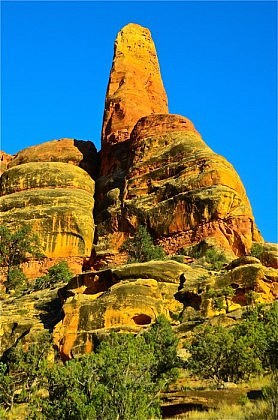From the biggest wild – Alaska’s Arctic National Wildlife Refuge – to the verdant Great Smokies, and from the red-walled canyons of Utah to the snowy Beartooths of Montana, about one third of the American landscape is public land. This means that all Americans are part “owners” of an invaluable but poorly appreciated legacy of federal lands where cities, suburbs, factories and strip malls yield to open space, wildlife, woods, wetlands and in some places, real wilderness.
The American concept of public lands is unique, yet few citizens know where these lands are (most, but not all, are in the West) or who is in charge of them. In a nutshell, there are four federal land management agencies, each with its own distinct mission, or less kindly, each with its own distinct set of biases and dogma.
Perhaps best known is the National Park Service (NPS), within the U.S. Department of the Interior. Obviously, this agency manages national parks such as Yellowstone, Grand Canyon and Olympic, but it also care-takes many national monuments and historic sites, such as the Gettysburg Battlefield and the Statue of Liberty. This agency is charged with preserving the national parks, unimpaired for the enjoyment of the public, a noble but nebulous mission that’s open to varying interpretations. That’s why there are roads and resorts throughout the national parks, often adjacent to big tracts of wilderness. It also partly explains why in some Utah parks the agency allows off-road vehicles in the backcountry (pressure from local economic interests is another reason for this). The NPS employs park rangers, not forest rangers, and park rangers often actually range through the backcountry.
Then there is the U.S. Fish and Wildlife Service (USFWS), also in the Interior Department. National Wildlife Refuges are central to the agency, but it is also charged with administering and enforcing the Endangered Species Act. Teddy Roosevelt founded the National Wildlife Refuge system by designating Florida’s Pelican Island as the first national wildlife refuge back in 1903. If you assume that perpetuating populations of native wildlife is a major focus of USFWS, that would be pretty close to the truth. Depending upon the actual charter of a given refuge, though, wildlife refuges may allow uses such as hunting, fishing, livestock grazing, water developments, road construction and other activities that may conflict with the basic agency mission.
The other Interior Department land management agency is the Bureau of Land Management (BLM), which manages a huge domain of mostly arid to semi-arid rangelands primarily throughout the Inter-mountain West. Unlike the NPS and the USFWS, the “Bureau of Livestock and Mining” manages not primarily for wildlife or preservation, but mainly for timber, mining, oil and gas, and livestock production. And its recreation management favors motorized recreation including all kinds of off-road vehicles. This philosophy is called “multiple use,” also know by many Westerners as “multiple abuse.” Indeed, a very big percentage of BLM land is in terrible ecological condition, laced with roads, mines, oil-rigs, pipelines, power lines, water projects, weed infestations and in many situations, way too many livestock for the carrying capacity of the land.
Unlike the NPS, USFWS and BLM, the U.S. Forest Service (USFS) is in the Department of Agriculture, which hints at its historic orientation, for according to some foresters, forests are little more than a crop. Like the BLM, the USFS is a “multiple use” agency, and it has a long history of prioritizing timber management; yet it was founded by Teddy Roosevelt with more noble ideals back in 1905. Within its huge 191 million acre domain is an environmentally destructive road network over 400,000 miles long, mostly built at taxpayer expense to facilitate logging. Roads and the associated clear-cuts have created huge environmental problems throughout the national forests. In fact, roughly 110 million acres – well over half – of the national forest system is classified as “roaded and developed”. Many forest rangers rarely range farther than the nearest office coffee machine, but there is a sub-culture of wilderness people in the agency, and the primary job of wilderness rangers is to range in designated national forest wilderness (see next paragraph). Our nation’s first national forest was the Yellowstone Forest Preserve, now known as the Shoshone National Forest in northwest Wyoming.
If you are getting the impression that much of America’s public domain is anything but protected, and frequently exploited and damaged for private gain, you’d be correct. Nonetheless, because they are vast, public lands are where our healthiest and most expansive natural landscapes remain. Various federal laws, including the National Environmental Policy Act, require the four land management agencies to solicit public input and conduct environmental reviews before undertaking potentially damaging projects on federal lands. In other words, unlike private lands, citizens have a say in how public lands are managed. This land is your land, this land is my land, and all American citizens have a right to be heard! In addition, in 1964 Congress passed the Wilderness Act, our nation’s foremost land protection law. In an upcoming blog, I’ll discuss this legislation and our National Wilderness Preservation System. For now, simply know that any relatively wild chunk of federal land managed by any of the four federal land management agencies can be designated by Congress as a “wilderness area,” which largely protects the land in its wild natural condition. Again, I’ll discuss wilderness in more depth in the near future.
Fairly, fitness and medicines are playing on the minds of humanity all around the World. Online drugstores provides best-quality recipe medicaments and other medications. One of the most pop preparation is Viagra. This article tell more about “http://cialis-price.biz“. Nearly every man knows about “http://cialis-price.biz“. Other matter we should is “http://cialis-price.biz“. Albeit sex is not vital for good soundness, it’s no doubt good for you. Other medicaments may interact with this preparation, including prescription herbal products. Not all feasible interactions are listed in standard medication guide. Stop using this remedy and get medic help if you have sudden vision loss.



